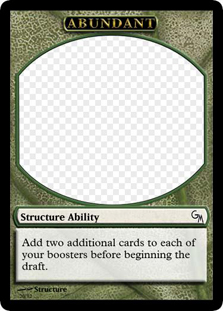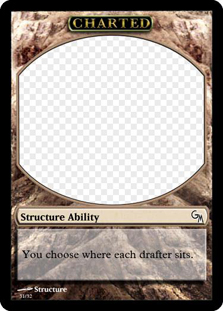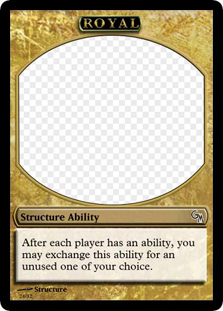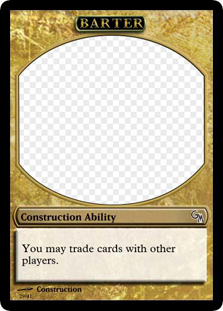As I obliquely hinted at last week, for the next little bit, I’m going to be taking a look at Cube Draft. This is a bit of a departure from the classic Magic design we’ve done thus far, but I hope you’ll enjoy it. That said, I realize that some portion of this column’s readership invested themselves in the nautical setting we were working on before Avacyn Restored was spoiled, so you can also read a wrap-up of that project here.
Doubling Cube
As for what exactly we’re doing with Cube, the obvious place to start was with Gregory Marques’s recently unveiled Cube: Legacy project. The format looks incredible, but it also requires a few things that a lot of people don’t have access to:
- The same Cube every session
- A consistent group of players
- The ability to print stickers
- Somewhere to keep packets
On top of that, the format is rather complicated, and it becomes progressively more so as cards gain new abilities from Draft to Draft.
I was thinking about these issues while talking to Adam Styborski (our amazing content manager here at GatheringMagic), and he suggested focusing on Draft abilities like the top half of this one from Gregory’s article:

Image from ChannelFireball.com
This subset of the Cube: Legacy experience is exactly what we’re looking for. Once designed, copies of the cards are easy to print up, so you can bring the sub-format to anyone’s Cube with ease, and it’ll work fine. On top of that, the cards’ complexity level stays the same, so somebody joining a Draft with these abilities for the first time isn’t at too much of a disadvantage against people who’ve been playing with them for a while.
Gregory mentioned that he had some abilities that functioned while drafting and some that worked during deck building and that he had to give them separate labels after players became confused as to when they could use their powers. But the Draft and the deck building aren’t the only parts of a Cube session. Obviously there are games, but there’s also some setup beforehand, and with that in mind, I divided my player abilities into four categories based on when they came up. Structure abilities have an effect before the first booster is opened, pick abilities alter the drafting process, deck-building abilities are exactly what they sound like, and game abilities are essentially emblems.
Down to Business
Going into this project, I really had no idea how Drafts would work best. Should each player get one ability from each category to promote synergy and new gameplay? Should each player only receive one power total to keep things simple? Or perhaps something in between would make for a good balance. In the end, I decided to just start things off with one card per player, and I only included structure abilities to keep things easy. With that, I started brainstorming, and I asked the Twittersphere for its input.
I didn’t specify which part of the Cube event to work with on Twitter, but in 140 characters, I only had room for one example, and judging by the number of ideas for powers that fit under pick abilities, I seem to have accidentally loaded the question. Regardless, I appreciate all of the input, and you’ll see more of it going forward. In the meantime, here are the eight structure abilities I brought to the table:

The idea behind this ability was to let its user play a sort of semi-Sealed by opening two boosters before drafting two, but the player who wound up with opted not to use the effect. It would have made more sense to take away the option and see how things played out, but the point of these effects is to let each player feel that he or she is doing something awesome, so if it’s not appealing enough to use, it probably shouldn’t exist in the first place.

I didn’t really have any idea how powerful the effects would be relative to one another without testing, so for designs like this one with adjustable numbers, my only options were to guess or to find some other reason to have particular numbers and hope they weren’t too strong or weak. Here, I attempted to make sure that the person who opened the pack would get an extra pick out of it, but there were a number of complications. First of all, you don’t always have eight people together to cube, and second, some people do fifteen-card Cube boosters and others use fourteen cards. In the end, I decided to weigh this effect for an eight-man Draft with fifteen-card boosters, but given how arbitrary that choice is, it holds little weight.
I wish I could tell you what the appropriate number for this design would be, but it was never played due to an unforeseen issue. It’s hard to keep track of cards in Cube, and you really don’t want to lose any. Normally, it’s just a matter of making sure that everyone turns in forty-five (or forty-three with fourteen-card packs) at the end, but the numbers are way too hard to track with this in the mix. Whoops!

Those of you who are playing close attention may recognize this power from Gregory Marques’s article. You may also recall that he called it a failure in part because it’s information overload. Were I any reasonable person, I’m sure I would have reread his piece before this endeavor, but instead, I plowed ahead and promptly hit many of the same pitfalls.

And apparently, I just didn’t think the last one was adequately mind-melting, so I made this. The player who ended up with this ability looked to me in confusion, and I decided to just have him separate the first picks he wanted into three different boosters.

Here, I ran headlong into Calculating’s other problem. Effects that don’t give you any cards feel much weaker than those that do—regardless of their actual power levels. In fact, we almost called off using these abilities because they felt so out of proportion. That said, the player who had this power made use of it (we drafted left, left, right) and said it did influence his Draft, so maybe the effect’s okay provided that it isn’t mixed with ones that directly add cards to players’ pools.

This power worked out the best of those we tested because it offers a concrete advantage and significantly impacts the direction of its owner’s Draft while still being simple to execute.

I didn’t even attempt to add this card to the pool. It seemed cool in my mind, but unless everybody knows one another really well, it doesn’t offer much of anything, and if they know each other that well, this shift doesn’t spice up the environment enough to be worthwhile.

This power likewise read well to me, but I didn’t put it in once I realized that we were running out of structure abilities (and I was still trying to use only structure abilities). Looking back at the successes and failures on this front, I’m not sure that having distinct categories for right before drafting and while drafting is worthwhile. In theory, it would help avoid a bit of confusion, but I ended up writing “before making a pick” on most of these anyway, and “structure” doesn’t exactly evoke “at the start.” Calling them something like “setup abilities” is an option, but I guess we’ll see how things shake out.
Practice Makes Practicality
I mentioned before that a lot of these abilities never made it to the drafting stage. We had six people cubing and only five usable structure abilities, so I ended up with a game ability instead.

I thought balancing between various structure abilities was tough, but trying to balance in-game effects against the potential to have a stronger deck was downright insane. This effect proved to be way too strong, and after one game, I changed it to:

This version promptly proved to be impossible to remember, so I just played the remainder of the Draft without an ability, and I think that was for the best. I mean, I could have continued tweaking this card to find something plausible, but by this point, I’d already decided that game abilities might not be such a great idea.
Gaming the System
The issue with game abilities stems from my failure to consider players who enjoy Magic differently than I do. I’m addicted to newness, and as such, I thought cards like Power Creep that push players toward an archetype they might not normally draft would be fun. But a lot of Magic players like a certain style of play and stick to it, and denying them the ability to draft that way in Cube undermines the reason they’re playing the format. Some potential game abilities (like starting with an extra card) are good for every deck, but Magic is an intricate enough game that no effect is equally good everywhere, and as such, every potential game ability pushes the drafter in one direction or another. This realization likewise spells death for deck-building abilities like this:

The other strike against game abilities is precisely that they act during the game. To draft with player abilities, everyone needs to be on board, and if somebody is accepting the change reluctantly, it’s best not to rub it in his or her face for the entire event.
The Great Beyond
I hope the next trial will prove less problematic, but even this first playtest was highly educational. Here are abilities I’m planning to use next; feel free to try them in a Cube Draft of your own, and be sure to share your thoughts in the comments.
 |
 |
 |
 |
 |
 |
 |
 |
[poll id="159"]
























